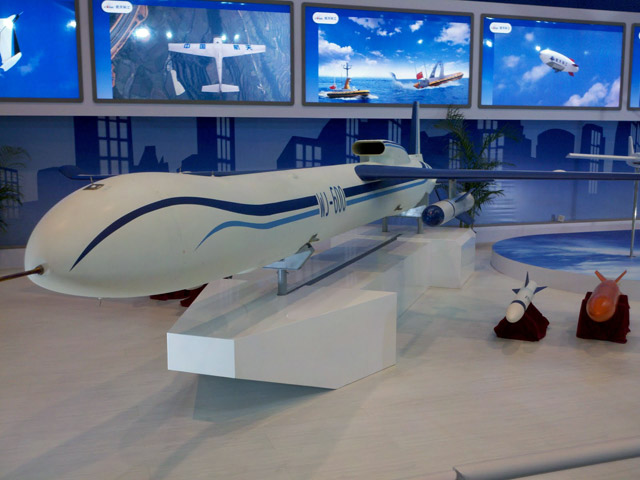Unmanned air vehicle models are a major attraction at Zhuhai, but how many will see the light of day?
The biennial Airshow China at Zhuhai offers foreign experts and the Chinese public a rare glimpse into the development of UAVs for the Chinese military and the eventual roles that Beijing hopes such systems will fill. In 2010, models for between 40 and 50 UAVs were displayed at the show. Concepts ranged from small tactical UAVs to large, high-altitude long-endurance UAVs equipped with anti-ship missiles.
 |
|---|
Greg Waldron/Flightglobal A full-scale mock-up of the WJ-600 drone on display at the 2010 show |
Besides the model displays at Zhuhai, information about China's UAV efforts is extremely thin and comes mainly from unsourced reports on Chinese defence blogs. One of Beijing's rare disclosures about UAV development occurred in July 2011, when a website sponsored by the People's Liberation Army issued a statement about a UAV called the Silver Eagle participating in a South China Sea naval exercise.
During a 3h flight, a ground operator controlled the Silver Eagle with a mouse and keyboard, according to the website. When the UAV reached the combat zone, it maintained a cruising speed of 72kt (133km/h) and an altitude of 9,840ft (3,000m).
During its mission, the Silver Eagle disrupted communications, while also acting as a node for a Chinese military communications network, relaying "large numbers of information packets" among Chinese forces. When an "enemy" aircraft approached, the ground control station initiated a "counter-surveillance deployment plan", it said. By reducing its altitude and initiating radio silence, the Silver Eagle evaded detection.
 |
|---|
Greg Waldron/Flightglobal The Chinese Pterodactyl drone resumbles the General Atomics Reaper, but how far along has development progressed? |
Another significant development, which China never officially acknowledged, was the operation of what appeared to be a Schiebel Camcopter S-100 from the deck of a Chinese frigate in the East China Sea. News reports from Austria have quoted Schiebel as saying that it sold Camcopters to China for civilian use. An industry source familiar with China's UAV sector says it is "common knowledge" in the industry that the country obtained 18 of the Austrian-built UAVs in 2010. Images of the Camcopter flight were released to journalists by the Japanese Maritime Self-Defence Force.
Other than these two events, China UAV watchers have had little to observe since 2010.
"That China is pursuing a range of UAV programmes, covering roles from tactical to strategic, appears clear," says Douglas Barrie, an air warfare analyst with the London-based International Institute for Strategic Studies. "What is less certain is the relationship between the modellers' paradise that is Zhuhai and actual PLA-funded programmes."
He believes key programmes to watch are any long-endurance intelligence, surveillance and reconnaissance UAVs as well as unmanned combat air vehicles. Barrie draws specific attention to the Harbin BZK-005, a high-altitude long-endurance UAV. A model of this type appeared at the 2006 show. In August 2011, images from northern China showed burning UAV wreckage, reportedly from the crash of a BZK-005.
Siemon Wezeman, a senior researcher at the Stockholm International Peace Research Institute (SIPRI), says Beijing is "very keen" to develop its UAV capabilities.
"Simple UAVs are simple, but the longer range ones with sensor packages are not something you just drum up," he says. "China seems willing to show things at a very early stage, but I am not sure this translates into operational capability."
He notes that the sheer number of UAV designs on display at Zhuhai could indicate a significant level of competition between different Chinese government firms.
Wezeman adds that Beijing will face a series of familiar challenges, namely the control of UAVs in hostile environments. This issue also relates to guided bombs and missiles. The other challenge he cites is that familiar Chinese aerospace bugbear of engine technology: high-altitude, long-endurance UAVs require very capable turbofans that can operate for up to 24h.
IISS's Barrie adds that Beijing will also face issues involving the integration of UAVs into operations, and in ensuring the platforms provide useful, actionable intelligence in a timely fashion - challenges that are by no means unique to China.
Source: Flight International























